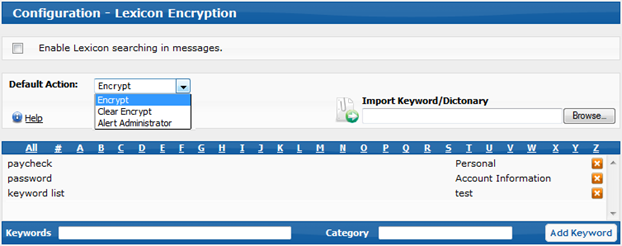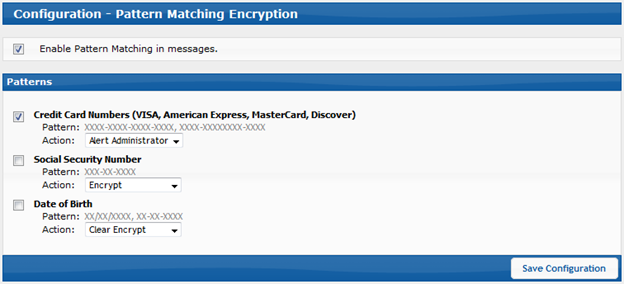ExchangeDefender–Lexicon & Pattern Matching Encryption
This week our main focus has been implementing more advanced encryption methods. These new additions will be available sometime next week and will require an additional fee to enable these features. This new system implements two new types of encryption “triggers” that will flag the messages and send them through the encryption process.
Lexicon Encryption
The first method is called Lexicon Encryption. This feature works by examining a pre-defined set of keywords that act as encryption triggers anytime they are encountered inside a message. Once a keyword is located inside of a message, that message is sent through our encryption process.
The [Default Action] determines the action that occurs once the message hits the encryption system. You can choose one of the following:
Encrypt
*This is the normal encryption process, which will deliver a secure link to the user’s mailbox and require a password to view the message.
Clear Encrypt
*This method is similar to the normal encryption method, except a password is not required to view the message.
Alert Administrator
*This method, delivers an encryption summary to the domain administrator and will require them to (view, deliver, delete) the message before it reaches the user.
We understand that some users may already have a predefined list from another 3rd party or software provider. So we have implemented a very simple “import” process which will allow you import these keyword definitions.
The format is .CSV and is implemented in the following sequence: (keyword, category)
Pattern Matching
The next method is called Pattern Matching. This approach examines the message for a series of common patterns found when referencing things like (credit card numbers, social security numbers and birthdays.) Later in the year we also plan on implementing custom pattern matching, which will allow you to enter your own custom defined patterns.
Once any of these patterns is located inside of a message, the same encryption process will occur. Unlike Lexicon matching, each individual pattern is allowed to have a different action. This will help route crucial and confidential information more accurately.
Hank Newman
VP Development, ExchangeDefender
hank@ownwebnow.com



